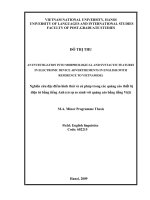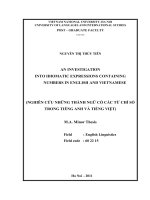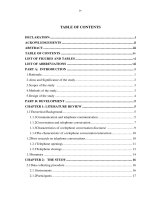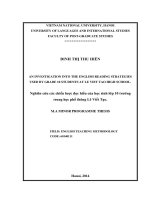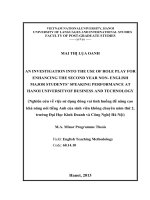an investigation into starting and closing telephone conversations between friends and relatives in american english and vietnamese = nghiên cứu phần mở đầu và kết thúc cuộc hội thoại qua điện thoại giữa bạn bè
Bạn đang xem bản rút gọn của tài liệu. Xem và tải ngay bản đầy đủ của tài liệu tại đây (717.5 KB, 71 trang )
iv
TABLE OF CONTENTS
DECLARATION .................................................................................................... i
ACKOWLEDGEMENTS ..................................................................................... ii
ABSTRACT .......................................................................................................... iii
TABLE OF CONTENTS ..................................................................................... iv
LIST OF FIGURES AND TABLES .................................................................... vi
LIST OF ABBREVIATIONS ............................................................................. vii
PART A: INTRODUCTION ............................................................................... 1
1.Rationale............................................................................................................. 1
2.Aims and Significance of the study ..................................................................... 2
3.Scopes of the study ........................................................................................... 3
4.Methods of the study........................................................................................... 3
5.Design of the study ............................................................................................. 4
PART B: DEVELOPMENT ................................................................................. 5
CHAPTER 1: LITERATURE REVIEW ............................................................. 5
1.1Theoretical Background .................................................................................... 5
1.1.1Communication and telephone communication .......................................... 5
1.1.2Conversation and telephone conversation ................................................... 7
1.1.3Characteristics of a telephone conversation discourse ............................... 9
1.1.4The characteristic of a telephone conversation interaction ........................ 10
1.2Prior research on telephone conversations. ...................................................... 10
1.2.1Telephone openings ................................................................................. 11
1.2.2Telephone closings ................................................................................... 13
1.3Summary ........................................................................................................ 14
CHAPTER 2: THE STUDY .............................................................................. 16
2.1Data collecting procedure ............................................................................... 16
2.1.1Instruments .............................................................................................. 16
2.1.2Participants .............................................................................................. 17
5
2.2Data analysis ................................................................................................... 17
2.2.1Findings from the data corpus .................................................................. 17
2.2.2Findings from the survey questionnaire .................................................... 25
2.2.3The similarities and differences of starting and closing telephone
conversations in American English and Vietnamese ...................................... 30
2.3Summary ........................................................................................................ 33
PART C: CONCLUSION ................................................................................... 34
1.Summary of the findings ................................................................................... 34
2.Limitations of the study .................................................................................... 36
3.Implications and suggestions for further research .............................................. 37
REFERENCES .................................................................................................... 39
Website: ............................................................................................................... 41
1. ................................................. 41
APPENDIX #1 ....................................................................................................... I
COMMON FRAMEWORK ................................................................................... I
Note: AmE: American English .................................................................. II
APPENDIX #2 ...................................................................................................... II
TRANSCRIPTION (American native speakers) ................................................... II
III
APPENDIX #3 .....................................................................................................XI
TRANSCRIPTION (Vietnamese native speakers) ............................................... XI
APPENDIX #4 ................................................................................................... XX
SURVEY QUESTIONNAIRE (For American Native Speakers) ....................... XX
APPENDIX #5 ............................................................................................... XXIII
BẢN CÂU HỎI KHẢO SÁT (Dành cho người Việt bản ngữ) ...................... XXIII
vi
LIST OF FIGURES AND TABLES
Figure 1. Frequency of the callees speak first .................................................... 26
Figure 2. Frequency of greeting the callers/ callees ........................................... 27
Figure 3. Frequency of asking what the caller/ callee doing .............................. 27
Figure 4. Frequency of the callees initiate final closing ..................................... 29
Figure 5. Frequency of expressing joy about engaging in the conversation ..... 29
Figure 6. Frequency of giving reasons to end the phone ................................... 30
Table 1. Occurrences of opening sequences ....................................................... 18
Table 2. Occurrences of closing sequence .......................................................... 22
Table 3. Sample of interaction with four phases analysis .................................. 23
Table 4. Frequency of acts in the openings......................................................... 25
Table 5. Frequency of acts in the closings .......................................................... 28
Table 6. Common opening patterns ...................................................................... I
Table 7. Common closing patterns ...................................................................... II
vii
LIST OF ABBREVIATIONS
AmE: American English
V1: Vietnamese
V: Vietnamese people
A: American People
T: Transcription
1
PART A: INTRODUCTION
1. Rationale
Nowadays, under the circumstance of globalization, telephone is a very popular
means of communication. It has been at every office, every home because of its
convenience. People use telephone for many purposes, for example, for business, chatting,
asking health, etc. People may talk with others wherever they are and whenever they want.
Using telephone is safe, fast and in some way, it is cheap.
We cannot deny the superiority of using telephone. Therefore, it is necessary to have
a successful telephone conversation. In order to achieve that, beside the main information
needed to convey through telephone, opening and starting are also important sections. The
opening may motivate both speakers while the ending may help the caller and the called
feels “satisfactory".
Conversation routines such as greeting and leave-taking may often be perceived as
mechanical, but they are certainly not meaningless. Although scholarly attention on
discourse and communication research has shifted to institutional settings, this is not
suggested that we can leave aside studies of casual conversations, which constitutes a
major part of our daily experience. A conversation is face-to-face communication but a
telephone conversation is non face-to-face communication. However, both of them are
face-threatening act.
Conversational analysis of telephone conversations has received much attention of
linguists as Hopper (1989), Godard (1977), Schegloff (1972, 1979, 1986), Schegloff and
Sacks (1973). Some cross-cultural studies on telephone conversations have been carried
out as Godard (1977), Hopper & Kolaeit Doany (1989). All telephone conversations, once
they start, must end, the way in which departure and termination achieve varies within and
across cultures. While telephone conversations in many languages and cultures have been
studied, the Vietnamese language is conspicuously absent in the literature.
Therefore, the author would like to choose the topic “An Investigation into
Telephone Conversation Openings and Closings between Friends and Relatives in
2
American English and Vietnamese” with the attempt to find out the similarities and
differences of the telephone conversation openings and closings in American English and
Vietnamese. An analysis of the opening and closing sequences of 15 dyads of telephone
conversations, which are transcribed from American records and Vietnamese records,
together with the synthesis data from the questionnaire are as serve for the study. The
current investigation hopes to contribute new data to a growing body of work on cultural
universalities vs. particularities in the functions performed in telephone opening and
closing sequences.
2. Aims and Significance of the study
The study deals with the exploitation of a formula in starting and ending telephone
conversations in Vietnamese language, which is done based on the study of telephone
conversation by Schegloff (1968, 1972, 1986) and Schegloff and Sacks (1973). The main
objective of this study is to find out the similarities and differences in opening and closing
telephone conversations in American English and Vietnamese. In other words, this study
aims specifically at:
- Exploring a formula of the beginning and ending of telephone conversations in
Vietnamese language.
- Discovering the similarities and differences of telephone openings as well as telephone
closings in American English and Vietnamese.
- Helping speakers of American English and Vietnamese get a better communication
when talking on the phone to have a successful telephone talk and improving their
communicative competence.
To serve the above-mentioned objectives, two research questions come out:
1. Based on Schegloff‟s theory of opening and closing sequences in American English, is
there a formula in beginning and closing telephone conversations in Vietnamese? If
there is, how is the act of telephone conversations, in terms of opening and closing
telephone conversations, realized by Vietnamese people?
2. What are the similarities and differences in starting and closing telephone conversations
in American English and Vietnamese?
3
The study should be of potential interest to those who care for telephone conversation
analysis. This is also a base for the American or Vietnamese to get a better communication
on the phone when using American English or Vietnamese. It can also be applied this in
teaching telephone communication.
3. Scopes of the study
In the study, the author would like to concentrate only on the opening and closing of
telephone conversation, not on the whole one.
Furthermore, the author tries to find out the similarities and differences of telephone
conversations in two languages: American English and Vietnamese. The similarities and
differences are found in verbal words, not in intonation or non-verbal words (such as
yelling).
The telephone conversations used for the research are the casual ones. That is, the
telephone conversations are between friends and relatives.
In addition, the author‟s interest in this area is inspired by studies in cross-cultural
communication. That is, cultural aspects between the two peoples, not only on linguistic
aspects would be mentioned. Some important cross-cultural similarities and differences in
telephone use between American English and Vietnamese are noticed.
4. Methods of the study
In this study, the theoretical background relies on the research of some foreign
researchers concerned with the subject. Especially, the structure of my analysis will be
heavily relied on frameworks pioneered by Schegloff (1968, 1972, 1986), Schegloff and
Sacks (1973) and further elaborated by Hopper (1989). The current work focuses on data
collected from recodered telephone conversations of native speakers of Vietnam and
America and the survey questionnaires. A combination of qualitative and quantitative
method is used to analyze the data. According to Larsen-Freeman and Long (1991), both
qualitative and quantitative paradigms are not competing, but complementary, and the
choice between the two is unnecessary. They also assert that much can be gained from a
combination of the two. Within this study, qualitative method helps the author give an
observation of the acts of how people in America and Vietnam open and close the
telephone conversations, which can be considered to be the basis for the content of the
4
survey questionnaire. Qualitative method also helps the author explain why American and
Vietnamese people act as doing so. The quantitative method is used to give frequency
counts of telephone opening and closing sequences in two languages. This method raises
the validity and realiability for the study.
There will be a comparative analysis in American English with Vietnamese as a fact
in two languages to achieve the exploitation and strategies. It is through such cross-cultural
comparisons that the greatest relevance to second language learning will be realized.
5. Design of the study
This minor thesis consists of three parts.
Part A is the introduction to the paper. It gives reasons for choosing the topic and
raises the research requirements: aims and significance of the study including research
questions; scopes and methods. This part also outlines the organization of the study.
Part B is the development of the research. In this part, there are two chapters.
Chapter 1 is the literature review. This chapter explicates some notions of
conversation and communication. Some prior researches on telephone conversations of
some linguists are reviewed in this chapter. Chapter 1 is a base for the analysis and
discussion in the later chapter.
Chapter 2 is the study. This chapter includes data collection and data analysis
procedure. Then the findings will be presented.
Part C is conclusion. It is the last part of the minor thesis that summarizes the major
points and deals with the limitation of the study as well as giving suggestions for further
study
Apart from the three parts, the references and appendices including transcription of
recorded telephone conversations in American English and Vietnamese and two survey
questionnaires are added in the end of the paper
5
PART B: DEVELOPMENT
CHAPTER 1: LITERATURE REVIEW
This chapter consists of two sub-parts. The first sub-part discusses some theoretical
background of the study in which focuses on some concepts about communication, crosscultural communication, communication between friends and relatives and conversation,
conversation analysis, telephone conversation. The second sub-part is concerned with
previous research on telephone openings and closings.
1.1 Theoretical Background
1.1.1 Communication and telephone communication
1.1.1.1 Definition of communication
No one can live without communication. As Wikipedia website, communication is
defined as “sending, giving, or exchanging information and ideas,” Thus; communication
is the acceptance of the senders‟ message by the receiver. If the receiver understands the
meaning of a message which asks for action but fails to act, the goal of communication is
not achieved.
According to Richard et al (1992) communication is „the exchange of ideas,
information, etc between two or more persons. The sender/ speaker transmits message to
the receiver/ listener”. However, communication is not merely an exchange of information.
This information is understood by the receiver in more or less the way it is intended by the
sender. An important function of communication is to keep a particular society going.
There are three forms of communication: graphic, verbal and non-verbal
communication.
Graphic communication is the act of using written words to exchange ideas, thought,
information, etc.
Non-verbal communication is the act of saying what is on your mind without
speaking words. The communication depends rather on other channels such as eye contact,
body language.
6
Verbal communication is the act of saying what is on your mind with words. It
means that you use language and speech to share or exchange information.
A communication can be formal or informal.
Informal communication usually uses with friends and family. During the
communication, people may use shortened version of words or slang words.
Formal communication uses in a professional setting such as in the office. In this
kind of communication, no slang is used and words are pronounced correctly.
1.1.1.2 Cross-cultural communication
Each culture has a unique character. Cultures adapt to meet specific sets of
circumstances, such as climate, level of technology, population, and geography. This
adaptation to different conditions is evident in differences in all elements of culture,
including norms, value and language. Therefore, Cross-culture is the exchange of culture
and the results of these changes.
Richards et al (1992) defines “cross-cultural communication is an exchange of ideas,
information, etc. between persons from different cultural backgrounds”. It is clear that
there are often more problems in cross-cultural communication than in communication
between people of the same culture background.
In cross-cultural communication, there may easily be misunderstanding and
communication failure. According to Gumperz (1982), the differences in cultures can
result in misunderstanding in cross-cultural transitions. That is caused under the affect of
some sociological factors such as age, sex, place of living, etc. The misunderstanding
becomes more acute when the interacting parties are using the same linguistic code but not
the same cultural nom. Despite conventionality, what is said and how it is sad is extremely
important in cross-cultural communication. Although the exchange of information is
certainly involved, the language behavior plays out within a set of social relation and
cultural expectation,
7
1.1.1.3 Communication between friends and relatives over the phone.
Generally saying, communication between friends and relatives is the one with very
close relationship. The participants know clearly about each other. The communication
may occur in the non-institutional setting.
Conversation routines such as greeting and leave-taking may often be perceived as
mechanical but they are certainly meaningless, as Laver (1981) rightly observes: “These
verbal behaviors can be understood as important strategies for the negotiation and social
relationship between participants in conversation.” Although scholarly attention on
discourse and communication research has shifted to institutional settings, this is not to
suggest that we can leave aside studies of casual conversation, which constitutes a major
part of our daily experience.
As being mentioned above, a conversation may be formal or informal.
Communication between friends and relative over the phone occurs in non-institutional
settings with a very close relationship. Therefore, this kind of communication is informal.
1.1.2 Conversation and telephone conversation
1.1.2.1 Conversation
Conversation is obviously with spoken rather than written language. It is necessary to
clarify the term “conversation”. There have been numbers of ideas about conversation.
Francesca Pridham (2001) sees “conversation as any interactive spoken exchange
between two or more people and can be:
- Face-to-face exchanges – these can be private conversations, such as talk at home
between the family, or more public and ritualized conversations such as classroom talk
or Question Time in the House of parliament;
- Non-face-to-face exchanges, such as telephone conversations;
- Broadcast materials such as a live radio phone-in or a television chat show”.
In another study, Rob Nolsco & Lois Arthur (1987), “conversation” refers to a time
when two or more people have the right to talk or listen without having to follow a fixed
schedule, such as an agenda. To have a successful conversation, participants must display a
willingness and ability to collaborate.
8
A conversation is not structured in advance. It is created by the parties in the process
of their conversing. Conversation structure is considered under pragmatics and discourse
view with two kinds: local structure and global structure.
Local structure includes turn-taking, adjacency pairs, preference organization and
conversation sequences.
- Turn-taking is seen as everything one speaker says before another speaker begins to
speak (Sacks et.al., 1974). Schegloff and Sacks (1973) share the same view that “a pair
is made up of two turns made by two different speakers”. It means that speakers
alternate: speaker A says something, then speaker B says, then speaker A….
- Adjacency pairs: adjacent sequence of two utterances, produced by different speakers,
ordered as First, Second,... both of particular type. Response pairs: question/ answer;
greeting/ greeting; invitation/ offer; acceptance/ apology …..
- Pre-sequence is a sequence which includes a turn recognizable as potential initiation of
another specific type of turn, eg:
Summon is a turn preceding an explanation for that summon
Global structure belongs to general class of verbal interchanges in which social activities
consists of talking. It is structured as follows:
- Opening section
- Substance section (topical organization)
- Closing section (organization ensuring coordinated exit)
In conclusion, Communication between humans is an extremely complicated and
ever-changing phenomenon. There have been numbers of definition and some even appear
to contrast to each other. Personally speaking, I prefer the idea of Finegan et Al. (1994),
which defines “A conversation can be viewed as a series of speech acts – greeting,
enquiries, congratulation, comments, invitations, request,… To accomplish the work of
these speech acts, some organization is essential: we take turn to speak, answer questions,
mark the beginning and end of conversation, and make corrections when they are needed”.
This definition seems to be the most satisfactory in order to assist me in carrying out
further study of starting and closing telephone conversations.
9
1.1.2.2 Conversation analysis
Conversation analysis (CA) originated from sociology in 1960s. The paper on the
organization of turn-taking for conversation written by Sacks, Schegloff and Jefferson in
1972 was the beginning of the CA approach era. Sacks and Schegloff mostly analyzed the
data from the calls to a suicide prevention centre, group therapy sessions and calls to a
disaster centre. Their analysis of these calls focused on generic features of the talk such as
turn-taking. Jefferson‟s contribution to CA was the development of the system of
transcription for CA. This transcription convention is one of the main features
distinguishing CA from other linguistic approaches of data analysis. It provides a
description of what is being said, how it is being said and what the recipient is doing while
it is being said.
1.1.2.3 Telephone conversation
A telephone conversation is the conversation over the phone denoting
communicative and contents. It relates only two parties. In other word, Telephone
conversation is a verbal communication. That is, two people use spoken words to
communicate over the phone. Like the conversation, a telephone conversation normally
proceeds in three stages:
a) Opening (sociability)
b) Main body (shifting topical focus)
c) Closing (sociability). At the end of the closing, both parties hang up.
The founder of the study of telephone conversations is Schegloff (1968, 1979, 1986)
who has noted that the opening is the place where a channel of communication as well as
an access is set up. In his research, he proposes the sequences of openings and closings of
telephone conversations which will be discussed later.
1.1.3 Characteristics of a telephone conversation discourse
- Synchronous talking: telephone conversations are considered a synchronous of
communication because a caller communicate with the called through the phone by
spoken in real time although (Greenfield & Subrahmanyam, 2003).
- Topics in turns: Several topics are discussed in turns. The two may have to several
10
conversations, and the streams of conversation often in order (Herring, 1999; Parrish,
2002).
- Using turn-taking rules, hence more input. Turn-taking and adjacency pairs are
compulsory. The caller and the called can only participate in one conversation at a time.
(Parrish, 2002)
- Lack of body languages: The environments of telephone conversation preclude face-toface cues such as eye contact, gaze, body orientation, and gesture that enable speakers
to know when they have an attentive listener and listeners to know whom a speaker is
addressing and what he/she is talking about. (Greenfield & Subrahmanyam, 2003)
1.1.4 The characteristic of a telephone conversation interaction
There are benefits of communicating over telephone. Let‟s examine some generic
properties of this type of interaction. When people are asked why they like using talking
over the phone, they generally mention things like (Coghlan 2004, Mynard 2002, d'Eỗa
2003):
- Immediate support, timely Feedback and getting answers faster (save time)
- Interactive discussion, more dynamic communication
- Less formal interaction, producing intimacy/closeness/warmth/ emotion
- Creating sense of urgency
- Greater interactivity, improving internal communication
- Better social relations, improves interactive competence
- Real time interaction of relationships
- Promoting active involvement, learner autonomy
- No restrictions regarding location.
1.2 Prior research on telephone conversations.
There has been numerous researchers pay much intention on telephone
conversations. Telephone conversations have been explored under many aspects and across
culture. Since the limitation of this study, only telephone openings and closings are
reviewed.
11
1.2.1 Telephone openings
Schegloff is the pioneer to be interested in telephone conversation opening with his
dissertation on it in the late 1960‟s. From that, a number of researchers have advanced the
study of telephone interactions, both inter-culture (Hopper 1989; Schegloff 1979;
Schegloff & Sacks 1973) and cross cultures (Godard 1977; Sifianou 1989). Many of the
researchers above concentrate on aspects of the opening and closing of telephone
conversation, such as turn-talking, initiation of sequences, etc.
The organization of telephone openings in French is explored by Godard (1977). She
suggests that there are some differences between summon-answer sequences in French
versus American telephone opening. Godard offers an objection to Schegloff‟s work. She
argues that his “summons-response” sequence cannot be universally applied, and maintains
that it is important to consider cultural aspects into consideration.
Sifianou (1989) finds that in Greek telephone openings, there is a greater variety of
linguistic options for the answering the phone.
In her study of Swedish telephone conversation openings, Lindstrom (1994)
describes how Swedes use a variety of responses when answering the phone.
Hopper and Schegloff are two researchers who individually have done much work in
the investigation of telephone conversations.
Hopper et al. (1990) use Schegloff‟s work to determine the extent to which
Schegloff‟s set of four opening sequences might be universally applicable and which
elements might be specific to North America culture.
Hopper & Chen (1996) investigate telephone openings in Taiwan. They explain
sequences in telephone conversations in Taiwan seem to be similar to the American
English.
And there are many more researchers has paid attention in this field such as
Houtkoop-Steenstra (1991) with Dutch telephone openings investigation, Pavlidou (1994)
with a comparision of Greek and German telephone conversation openings.
In Vietnam, the investigation into telephone conversations, both seems to be absent
in the Vietnamese language.
All of the researchers cited above raise valid points to keep in mind when analyzing
data from another culture. However, I find very persuasive Hopper et al.‟s (1990) assertion
12
that “Schegloff‟s discussion of telephone opening and closing sequences includes virtually
every format that have been argued as being unique to Greece, France or Holland- and all
from North America data!”. Overall, I will rely heavily on frameworks pioneered by
Schegloff (1968, 1972, 1986), Schegloff and Sack (1973) and further elaborated by Hopper
(1989) in structuring my analysis.
Four core opening sequences in Schegloff’ s theory.
Schegloff(1986) has noted that the opening is the place where a channel of
communication as well as an access is set up. In his study, there exists an ordered set of
four core opening sequences: summons-response sequence (the phone ring and hello);
identification-recognition sequence (Tim?/ yes); a greeting adjacency pair (hi/hi); a “how
you are” adjacency pair (how are you?/ I‟m alright, how are you?) (Schegloff, 1972)
For example
(ring)
1.Nancy: Hello?
(Summon-aswer)
2.Hyla: Hi. Nancy? Me, Hyla
(Identification/recognition)
3.Nancy: Oh,Hi
(Greeting)
4.Hyla: How are you?
(Exchange of how you are)
5.Nancy: Fine, how‟re you?
1) Summons-answer: Schegloff (1986) finds that in ordinary call, telephone‟s ring
constitutes a summoning act, and any answer to that act demonstrates “the availability of
an attentive ear and a mouth ready to speak” Schegloff (1986). The adjacency pair
(summons-answer) prescribes that the answerer speaks first by providing his or her voice
sample. The summons-answer sequence in line 1 opens a channel and confirms the
availability of both the speaker and the hearer.
2) Identification or recognition: A caller in ordinary conversation may respond with just
“Hello” or may continue by addressing the answerer, or by providing self-identification of
by initiating the topic of the conversation. The form of address or self-identification
depends on the relationship between the two parties (Schegloff 1968). Thus, identification
or recognition sequence is the place where the relationship between the speakers is
established. The identification/ recognition sequence in line 2 establishes the identities or
relationship of the two interlocutors.
13
3) Greetings: After the identification, greetings may be exchanged. This may be done in
many ways. For example, a caller may use address terms to an answerer or use greeting
terms. Greeting tokens may be combined with address terms or just a simple “hello” or
“hi”. There is no neat mapping between sequences or sequence type in the openings
(Schegloff 1986). The greeting sequence in line 3 not only puts the participants into “a
ritual state of ratified mutual participation” (Goffman 1963) but also identifies the
speakers‟ relationship.
4) The “How are you?”: Although the “How are you?” can serve as “greeting substitute”
(Sack et al., 1974), Schegloff (1986) has stated that, in the context of openings of
telephone conversation, “how are you?” is not “greeting substitute”, but addresses the
current state of recipient. He also argues that the answer to „how are you?” is relevant to
the next turn of the talk. For example, the response to “how are you?” in ordinary
conversation can be organized into three sets: positive (really good), negative (terrible) and
neutral (fine or okey) (Schegloff 1986). It is found that English speakers use exchange of
“how are you?” as a bridge where the reason for the call or first topic is introducred. The
exchange of “how are you?” sequence in line 4, 5 has features of greetings and is a
pathway to the first topic, setting the direction of the talk.
1.2.2 Telephone closings
As telephone openings, closing parts are also received much attention of researchers,
by far Schegloff and Sacks are the most. The structures of telephone closings have been
well explored in conversation analysis (Schegloff and Sacks, 1973; Jefferson, 1973).
Schegloff and Sacks (1973) have argued that speakers follow orderly sequences in closing
the telephone conversation. They have observed that participants employ certain
procedures to signal their desire to bring the conversation to the end. Schegloff (1979)
identifys markers in American English that they call “pre-closings” such as “well”, “right”,
“okey”. It means that, one party is ready to terminate the conversation over the phone but
is offering the other party the opportunity to open another topic of conversation. These
“pre-closings” can take various forms. They also have suggested that the conversational
procedures in the closings are of a universal character (Schegloff and Sacks 1973).
Schegloff (1979) describes various stages of closing but without giving precise name to all
of them. However, the author of this study would like to tentatively put them in to the
14
following categories: (1) Pre-closing, (2) Shutting down, (3) Recapitulation, (4) Terminal
exchange
Four core closing sequences
1) Pre-closing: A way of initiating a closing such as “Okay”, “All right”, “So”, “Well”,
etc. Not all sequences “Okay” and “Well” are pre-closings. They are pre-closing only if
they occur after a topic boundary. (Schegloff and Sacks 1973)
2) Shutting down: an utterances serving to finish up a previously mentioned topic, such as
“That‟s all” „Well, The baby is crying”, “It‟s late now”, “I have something else to
do”…etc.
3) Recapitulation: involves a brief summarizing of the topic discussed and/ or
arrangements made. Recapitulation also includes such elements as sending best wishes
to other family members and other shutting down details for the sack of simplicity. Such
recapitulation is often an optional element in a personal conversation.
4) Terminal exchange: are the actual “goodbyes” or some equivalent appropriate to the
specific context of the conversation such as „Bye‟, „Cheer‟, „OK‟, „See you‟,
„Goodbye‟, „You‟re welcome‟
For the example quoted from an informal telephone conversation by two American
interlocutors, which was transcribed (Tapescript 7 - Appendix #1) as the following:
Pre-closing
A: Alright
T: Oh, yes
Shutting down
A: That‟s the reason for the call
Recapitulation
T: Oh I know, we‟ll meet tonight
A: Ahha. It‟d better to stop the phone now
T: Yes. You‟re alright
A: Ok. See you later
T: Yes. Take it easy.
Terminal exchange
A: Bye
T: Bye
15
1.3 Summary
Briefly, the chapter has revised theory relating to communication and conversation.
Telephoning is a means of communication. Thus, conversation analysis together with
telephone conversation characteristics has been concerned in this paper. Prior researches of
telephone conversations have also been mentioned, in which Schegloff‟s sequences of
telephone openings and closings are focused. It is the database of data analysis in the later
chapter. Based on the framework of Schegloff, the researcher wishes to discover the norms
of opening and closing telephone conversations in Vietnam as well as find out the cultural
cross of telephone openings and closings between Vietnamese and American people.
16
CHAPTER 2: THE STUDY
In the preceding, the literature on the research topic was briefly reviewed to form the
theoretical basic for the whole study. Turning to practical side, this chapter firstly presents
data collecting procedure, in which instruments and participants are discussed in detail.
Then an analysis of the collected data is carried out to maximize the validity and reliability.
2.1 Data collecting procedure
2.1.1 Instruments
The instruments used to collect data is the corpus study and the survey questionnaire.
The corpus consists of a databank of natural texts, compiling from writing and/ or a
transcription of recorded speech. The main focus of corpus linguistics is to discover
patterns of authentic language use through analysis of actual usage. The aim of a corpus
based analysis is not to generate theories of what is possible in the language. Its only
concern is the usage patterns of the empirical data and what that reveals to us about
language behavior (Elena, 2001).
In this study, two corpora include 15 American English texts and 15 Vietnamese
texts (see appendix #1 & appendix #2) transcribed from fifteen dyads of recorded
telephone conversations of native speakers. Using the corpus study is appropriate and
sufficient for this research because the aim of the author is to focus on the objective view
of language more than to discover its rules. One advantage of corpus study is that it can
investigate almost any language patterns.
The survey questionnaire for this study includes thirteen questions, in which there are
seven questions relating to telephone opening and six questions relating to telephone
closing. One questionnaire is written in Vietnamese to survey Vietnamese native speakers
and one is written in English to survey American native speakers but the content and
outline of the two questionnaires are the same. The questionnaire is designed in multiple
choices (MCQs) (Gillham, 2000) to show the frequency of people act in the telephone
openings and closings. The content of the question bases on Schegloff‟s ideas about
telephone openings and closings (Schegloff,1968, 1972, 1986). MCQs is an appropriate
instrument for gathering information in this study as the researcher can survey a large
17
number of respondents in a short time and the information from questionnaire can be
confidential for the respondent.
2.1.2 Participants
The survey questionnaires are delivered to 46 Vietnamese and 46 American people
in which there are 24 Vietnamese women and 20 American women. 30 Vietnamese and 35
American informants live in the city, the rest live in the countryside. The informants range
in age between 22 and 60 years old. The Questionnaires are mostly sent to the informants
via email as by this way the researcher can survey on a great number of informants from a
far distances and it is easy quick and time- saving.
Participants in the fifteen dyads of recorded telephone conversations are 10
American speakers and 12 Vietnamese speakers. All Vietnamese participants and most of
the American participants are living and working in Vietnam. Each particiapant
participates in more than one conversation. However, age, sex and social backgrounds of
the participants are various, and there is no information collected in terms of relationships
of the interlocutors of each phone conversation. However, the telephone calls include
conversations between friends and relatives. In doing so, the callers were asked to audiotape telephone calls initiated by themselves from their home. The conversations are
naturalistic telephone calls in the sense that the callers were instructed to only make and
record calls as communication needs arose. These recorded telephone conversations made
to family, friends, and relatives to keep in touch.
Due to the acquaintance limitation as well as the restriction of time and ability,
collected data are only 46 dyads of survey questionnaires and 15 dyads of recorded
telephone conversations. However, it is thought that those numbers are valid enough for
the study.
2.2 Data analysis
2.2.1 Findings from the data corpus
Data are transcribed texts collected from the 15 dyads of telephone conversations
recorded naturally. The aim of the records is to seek out the patterns of opening and
closing of telephone conversations in Vietnamese. The categories are based on the four
18
core sequences of Schegloff. The American English data corpus is to reaffirm Schegloff‟s
theory of opening (Schegloff 1968) and closing patterns (Schegloff and Sacks 1973). I did
a simple count on how many of the categories for openings and closings appeared in the
data. After this initial counting step, I returned to look more closely at the actual text to
find examples in support of both concordances and differences between the data and the
current theories. After all, major similarities and differences between one‟s own cultures
are highlighted.
Openings
Schegloff proposed four available adjacency pair sequences in telephone
conversational openings: summons/ answer; identification/ recognition; greeting sequence,
and the “how you are” sequence. I have previously mentioned to the definition of the four
categories. “hello/ hi” in the summons/ answer sequence does not serve as a greeting, but
rather answer to the summons of the ringing of the telephone. Therefore, once recognition
is achieved, in many cases the participants will do an additional “hello/ hi” which functions
this time as an actual greeting to a known interlocutor.
Table 1. Occurrences of opening sequences
Categories
1. Summons/ responses (Eg:
The bell rings/ Hello)
Number of occurrences in Number of occurrences in
Vietnamese
American English
86.7%
93.3 %
100%
100%
20%
53.3%
80%
73%
2. Identification/
recognization (Eg: Tim? Yes.
Oh, Michael)
3. A greeting adjacency pair
(hi/hi)
4. A “how you are” adjacency
pair (how are you?/ I‟m
alright, how are you?)
19
In the table above, I summarize the number of occurrences of each sequence found in the
fifteen samples of telephone conversations between friends and relatives which are
transcribed from the records.
The numbers of occurrences of four phases in American English confirm Schegloff‟s
theory about telephone opening sequences. Thus, the number of collected data is reliable
enough to carry out the research and support for the study. It is the base for the analysis of
the data and the base to compare the strategies of the two languages.
The table 1 shows that mostly, there are frequently used patterns in each of the four
phases of opening telephone conversations. However, greeting adjacency pair only appears
20% in Vietnamese language while other phases appear not less than 80%. Thus, greeting
adjacency pair is not often used by Vietnamese people. Clearly, if we look at nothing but
the numbers, there appears to be a strong fit with Schegloff‟s suggested categories. A
telephone call may involve in two consecutive conversations in a single call. When the
telephone was passed to the second member, both parties already knew who was going to
be on the line, and so there was no need for this sequence between them. Essentially, the
identification/ recognition was carried out in advance of the beginning of their
conversation.
The following extract is an example of the most typical opening sequences:
0 “ring ring ring” (the bell of the telephone)
1 H: Alo (Hello)
2 D: Alo, Hạnh có phải khơng? (Hello, Is that Hanh?)
3 H: Vâng ạ. Ai đó ạ? (Yes. Who‟s that?)
4 D: Dung đây mà, không nhận ra giọng à? (Dung, don‟t you recognize me by my voice?)
5 H: À, Dung à, lâu ngày quá. Khỏe không? (Ah, Dung, long time no see. How are you?)
6 D: Khỏe. Thế Hạnh và gia đình thì sao? (Fine. How about you and your family?)
7 H: Cảm ơn nha, mình và cả nhà khỏe cả. (Thanks, my family and I are well)
( tapescript 21- appendix#2)
……………………………………
8 “ring ring ring”(The bell of the telephone)
20
9 T: Alo! (Hello)
10 A: Anh Tường hả? (Tường, isn‟t it?)
11 T: Ờ (Yes)
12 A: Khỏe hông? (How are you?)
13 T: Ờ, anh khỏe, em đang làm gì đấy? (Well, I‟m fine. What are you doing?)
14 A: Em đang trong Sài Gòn đây. (I‟m in Sai Gon)
15 T: Ở trong Sài Gòn à? Vào Sài Gòn sớm thế? (In Sai Gon? Why do you go to SG so
early?)
16 A: Em vào được 2 tuần rồi (I have gone here for 2 weeks)
(Tapescript 16 - appendix #2)
Lines 0, 1, 8, 9, show the summons/ response sequence: “Ring, ring, ring” and
“Hello”. Lines 2, 3, 4, 10, 11 show the process of the identification/ recognition sequence,
which in this case actually takes two talking turns for each participant. The answer to
summons in lines 2 ad 9 - “Hello” may offer voice samples for recognition by the other
party.
Normally, every phone conversation initiates by the answer to the summons of the
phone bell. It is as a “signal” to show that there is someone picking up the receiver. The
following step is to identify who is involving in the conversation. This step is a must in any
telephone conversations if there is the answer to summons of the bell of the phone.
According to Schegloff, after the interlocutors recognize each other, they often greet to
each other. As the number of occurrences in Vietnam, only 20% Vietnamese people greet
their co-participants in the beginnings of the conversation. This stage seems to be not
popular when Vietnamese people talk to their friends or relatives over the phone. It is
supposed that in Vietnam the greeting sequences “hello/ hi” often occur among people who
are different age, social background…and in “formal” situations. To Vietnamese people,
friends and relatives are in close relationships so in the telephone conversations, greeting to
each other after recognition is rare. This action may sometimes occur when the
interlocutors are different ages and the conversations might be, in some way, a little
“formal” one.
21
One quality of Vietnamese people is care for each other. That‟s why the number of
occurrences in the “how you are” sequence appears 80 %. The questions about privacy
express the interests in the partner. In this sequence, people not only ask about one‟s
health, they may also ask some other questions, just for showing the concern on their coparticipants. Such the questions are “what are you doing? (line 13 or see T18, 24- appendix
#2) or “Have you eaten?” (see T23, 24- appendix #2) etc. This seems to be in contrast to
the American, these questions may be perceived as rude and infringement of private life. In
this stage, the popular action of the American is caring about the other‟s health with “how
are you?” and answers “well/ good/ I‟m fine”. Thus, I would like to call the “how you are”
sequence of the opening telephone conversation that Schegloff has proposed in American
English by the “inquiry” sequence in Vietnamese. The inquiry sequences include not only
“how are you?”, but also extended questions such as “what are you doing?” or “have you
eaten” etc. These inquiries reflect Vietnamese culture: the caring quality of each other, not
the curiosity.
In sum, the openings of telephone conversations in Vietnamese often follow three
stages: summons/ answer (the bell of the ring and anwer “Alo”(hello) ); identification/
recognition ( who‟s that? Is this Dung? It‟s me, Thai …); and the inquiry (how are you?
What are you doing? …).
Closings
Closing the telephone conversation is realized by the cooperation from both
interlocutors. Based on the above Schegloff and Sacks‟ (1973), this study tries to explore if
there is a formula of telephone closings in Vietnamese language. An analysis of the corpus
of the transcription of telephone conversation records in Vietnamese is made based on the
following sections that Schegloff and Sack (1973) proposed: (1) Pre-closing is a way of
giving signal to initiate a closing by using such terms are “Okay”, “All right”, “So”,
“Well”, etc.; (2) Shutting down is the use of expressions to start the ending part of the
telephone conversations such as giving reasons for closing the topic and ending the phone
calls; (3) Recapitulation involves a brief summarizing of the topic discussed and/ or
arrangements made. Recapitulation also includes such elements as sending best wishes to
other family members and other shutting down details for the sack of simplicity. Such
recapitulation is often an optional element in a personal conversation and (4) Terminal

